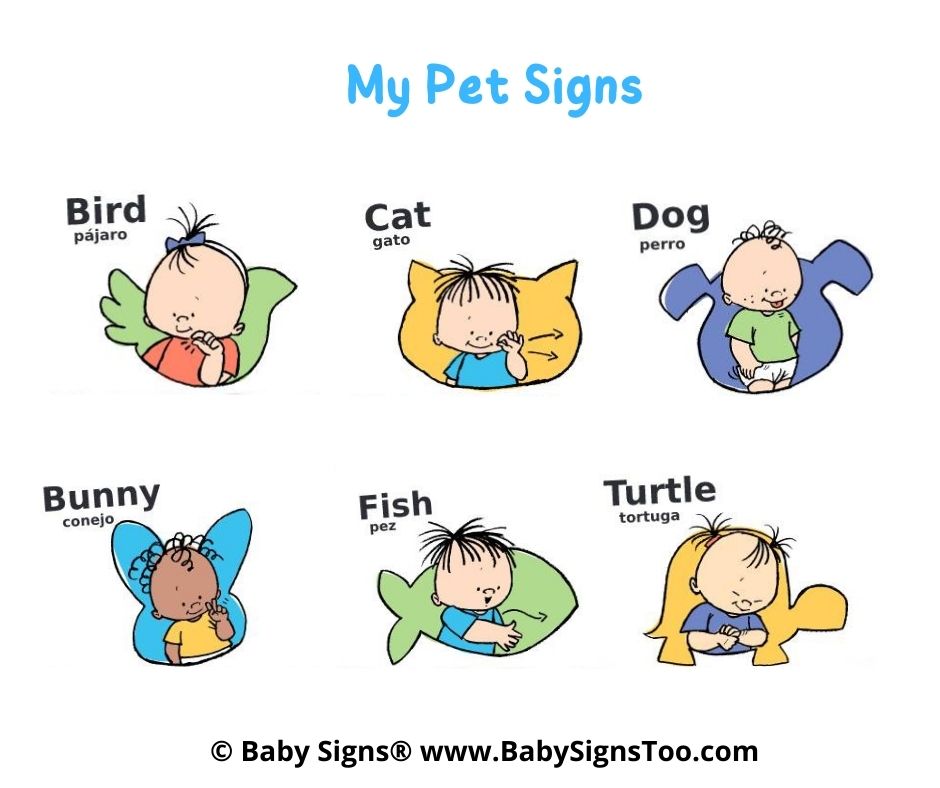
Why Kids Love Animals
Ever wonder why children, even babies, are so drawn to animals? Even linguists have long been aware of this attraction. Turns out that more than a third of the average baby’s earliest words are names for animals with “cat,” “dog,” “bird,” and “bunny” leading the pack. What’s more, we see a similar trend among signs.

But why do children find animals fascinating? Is it because so many children’s books feature animals, thereby inspiring the preference? Or, to turn this theory on its ear, do so many books feature animals because the preference already exists? It seems clear to me that the latter is the case. I simply can’t imagine that inundating a young child with books about pieces of furniture instead of animals would create a passion for chairs and tables that could rival that for dogs and cats!
What lies behind kids’ attraction to animals is really quite simple, researchers tell us. As young babies begin looking around their world, they are automatically attracted to things that move, are brightly colored, and are easy to see. They are fascinated by things that make interesting noises, are capable of interacting with them and are unpredictable in what they do and how they behave. The most obvious items that fit this description are other people. And, in fact, from the day they are born, babies are absolutely fascinated by the faces and voices of the people around them.

But humans aren’t the only things in the world that meet these criteria. Animals do, too. In sharp contrast to even the most exciting mechanical toy, an animal moves itself around, behaves in unpredictable ways, and makes funny noises. What’s more, many of the animals children see at close range have the added advantage of providing what researchers call “contact comfort”—or what most people call being soft and cuddly! In other words, babies find animals about as far from boring as things can be without being human.
So, whatever you do, don’t stop your signing efforts with signs for “eat,” “milk,” more,” and other mealtime signs. Your baby want to let you know about what is particularly fascinating in the about the world around him or her—and that definitely means signs for animals will be winners!

From the moment a child first lays eyes on a furry kitten, a playful puppy, or a gentle giant at the zoo, there is an undeniable bond that forms between children and animals. This enchanting connection is a testament to the profound and innate love that children have for the animal kingdom. In this blog post, we’ll delve into the reasons why children are naturally drawn to animals and explore the many benefits that this connection brings to their lives.
Unconditional Love and Acceptance
Animals offer something that every child craves – unconditional love and acceptance. Animals don’t judge, criticize, or discriminate. They offer a kind of companionship that is free from the complexities of human relationships. A child can approach an animal without fear of rejection, and this sense of safety and trust is incredibly comforting for them.
Empathy and Compassion
Interacting with animals fosters empathy and compassion in children. Caring for a pet or even observing wildlife encourages kids to consider the needs and feelings of others. Feeding, grooming, and playing with animals teach responsibility and instill a sense of empathy as they recognize the animal’s dependence on them for care and affection.
Connection to Nature
In our increasingly digital world, children often spend more time indoors than outside. Animals provide a bridge to the natural world. Whether it’s feeding ducks at the pond, hiking in the wilderness, or simply observing insects in the backyard, children connect with the environment through their interactions with animals. This connection fosters an appreciation for nature and the importance of preserving it.
Learning Opportunities
Animals offer valuable learning opportunities for children. They can teach kids about biology, anatomy, and the circle of life. Observing animal behavior helps children understand concepts like social hierarchies, communication, and adaptation. These experiences stimulate curiosity and a thirst for knowledge.
Emotional Support
Animals offer emotional support and comfort to children during difficult times. Whether a child is upset, lonely, or anxious, the presence of a beloved pet can provide solace and a source of comfort. This emotional connection helps children cope with the challenges of growing up.
Play and Entertainment
Animals are a source of endless amusement for children. From the playful antics of a kitten to the agility of a dog in a game of fetch, animals are inherently entertaining. This playfulness enhances a child’s imagination and creativity as they engage in games and storytelling involving their animal friends.
Unwavering Loyalty
Children cherish the loyalty of their animal companions. Dogs, in particular, are renowned for their unwavering loyalty and devotion to their human family members. This loyalty helps children build trust in relationships and understand the importance of being dependable and loyal in return.
The love that children have for animals is a timeless and beautiful aspect of childhood. This connection offers countless benefits, from emotional support and learning opportunities to nurturing empathy and compassion. As parents and caregivers, we can encourage and cultivate this love by fostering responsible pet ownership and creating opportunities for children to interact with animals in safe and educational ways. Ultimately, the bond between children and animals is a magical one that enriches their lives in profound and heartwarming ways.
Teach your baby animal signs with these resources from the Baby® Signs Program!
https://babysignsinc.blogspot.com/2011/09/why-kids-love-animals.html
#BabySigns #BabySignLanguage #SignLanguage #KidsAndAnimals #AnimalLove #ChildrensConnection #EmpathyThroughAnimals #KidsAndPets #CompassionateKids #AnimalBond #LearningFromAnimals
